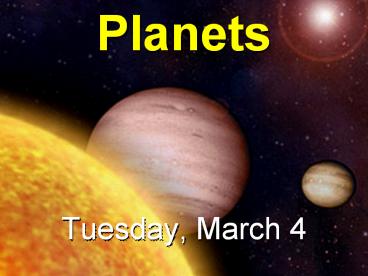Planets - PowerPoint PPT Presentation
Title:
Planets
Description:
For decades, Pluto was called the 'ninth planet'...though a very unusual planet. ... Are Pluto and Eris planets? International Astronomical Union definition of ' ... – PowerPoint PPT presentation
Number of Views:125
Avg rating:3.0/5.0
Title: Planets
1
Planets
- Tuesday, March 4
2
Tue, Mar 4 Planets Problem Set 7
due Thu, Mar 6 Past Future Problem Set 7
returned Tue, Mar 11, 130 pm Final
Exam Comprehensive
Same format as midterm
3
What is a planet?
Examples of planets
4
What is a planet?
A ball of gas, liquid, and/or solid,
orbiting a star,
whose size is neither too big nor too small for a
planet.
5
Planets are smaller than stars.
Within the Solar System, the
mass of the Sun is 1000 the
mass of Jupiter.
6
How small can a ball of gas be and still qualify
as a star?
A star has nuclear fusion occurring in its
interior.
Fusion of hydrogen to helium requires T 10
million Kelvin.
7
A star is in hydrostatic equilibrium.
The smaller a ball of gas, the lower the central
pressure and temperature needed for hydrostatic
equilibrium.
If stars mass temperature
8
A ball of gas with less than 8 the Suns mass is
not a star.
It is what astronomers call a brown dwarf.
9
Brown dwarf failed star. Like a
star, it is a ball of gas. Like a
star, it radiates light. Unlike a star,
it doesnt have a fusion engine, so it
cools down.
10
How does a planet differ from a brown dwarf?
Planets are not completely gaseous.
Planets are differentiated (layers of different
chemical composition).
Planets are lower in mass.
11
Object Mass
star 80
Jupiters
brown dwarf 13 to 80 Jupiters
planet Jupiters
12
Upper limit on a planets mass is 13
Jupiters.
Whats a sensible lower limit for a
planets mass?
Sun is orbited by lots of small junk asteroids,
comets, dust grains, etc
Where do we draw the line?
13
The Pluto Chronicles starting with discovery
in 1930
January 23, 1930
January 29, 1930
14
For decades, Pluto was called the ninth
planetthough a very unusual planet.
High orbital eccentricity. Large orbital tilt
(inclination). Very small!
15
Around 1990, searches began for more objects in
the region beyond Neptune.
Search technique look for faint objects that
move at the appropriate rate.
16
Over 800 objects are known with orbits bigger
than Neptunes.
17
Largest trans-Neptunian object yet known
discovered Jan. 2005.
Given the name Eris.
18
Eris is slightly larger than Pluto.
If Pluto is a planet, then Eris is too.
19
Are Pluto and Eris planets?
- International Astronomical Union definition of
planet - Orbits the Sun (or other star)
- Is big enough to be spherical
- Has cleared its orbit of smaller objects.
20
?Eris
Pluto ?
21
Its useful to place Eris and Pluto in a new
category dwarf planets
Orbiting Sun, spherical, but not massive enough
to dominate their neighbors.
22
Until recently, nothing was known about
exoplanets (planets around stars other than the
Sun).
Now, its a hot topic of astronomical research.
23
Planets can be detected from the Doppler shift of
their parent star.
Jupiter the Sun each orbit the center of mass
of the Sun Jupiter system.
24
Suns orbital speed 0.001 Jupiters orbital
speed 12.5 meters/sec.
Look for variations in the Doppler shift of the
Suns light!
25
A shortcoming of this radial velocity method
It works only if the stars speed is large enough
to be measured. This happens when the planet is
(1) massive and
(2)
close to the star.
26
Planets can be detected when they eclipse (or
transit) their parent star.
During a transit of Venus across the Sun, the
Suns flux dips slightly.
27
When a distant star is transited by one of its
planets, its brightness drops slightly.
Time between transits tells us planets orbital
period.
Amount of dimming tells us size of planet.
28
A shortcoming of this transit method
It works only if the dimming of the star is
large enough to be measured. This happens when
the planet is big.
29
First exoplanet was found in 1995.
Found by radial velocity method, orbiting 51
Pegasi, a Sun-like star.
30
Radial velocity wobble of 51 Pegasi.
Planet mass ½ Jupiter P 4.2 days
a 0.05 AU
31
A star with a well-studied exoplanet HD 209458
After the star was found to have variations in
its Doppler shift, it was found to have dips in
brightness.
32
Transit of HD 209458 by its planet
Mass of planet 0.685 Jupiter Radius 1.42
Jupiter Density 0.3 water
33
Over 200 planets have been found around stars
other than the Sun.
known multiple planet systems ?
34
One interesting system Gliese 581
Star dim red dwarf
35
The middle planet is in the Goldilocks zone.
Inner planet is too hot for liquid water. Outer
planet is too cold for liquid water. Middle
planet is just right.
36
How can we find whether a planet in the
Goldilocks zone harbors life?
Most forms of life are inconspicuous from a
distance. (Sorry, Marvin!)
37
Spectra of planets
Earth shows absorption lines of water and oxygen.
38
Earth shows the presence of water (essential for
life-as-we-know-it) oxygen (byproduct of life).
Exoplanets with similar spectra may have similar
life.
NASA Terrestrial Planet Finder (to launch around
2014)





























